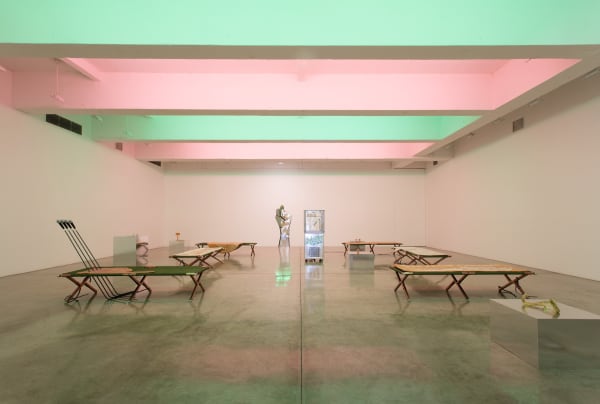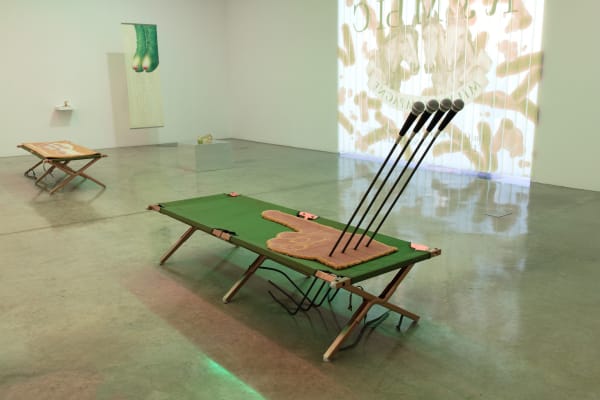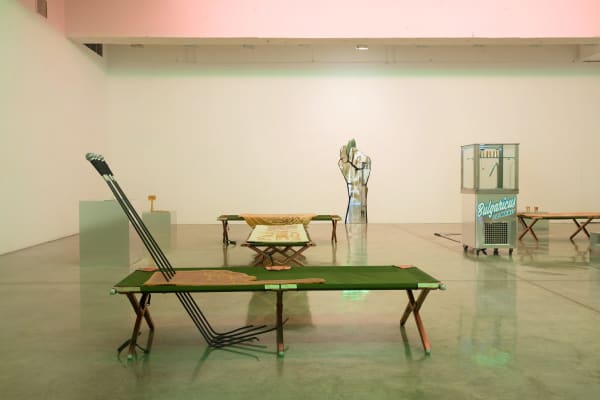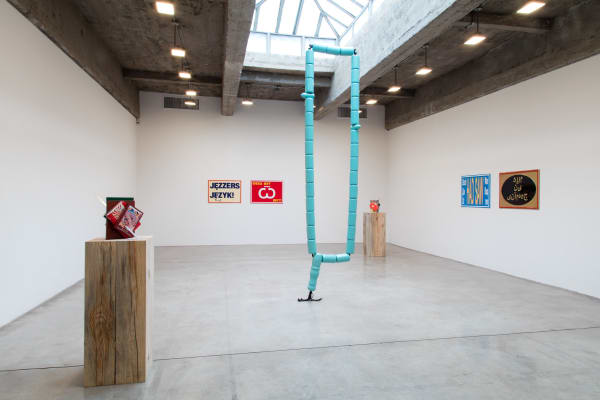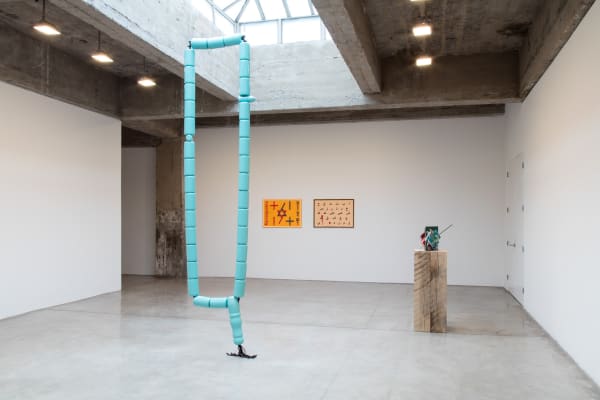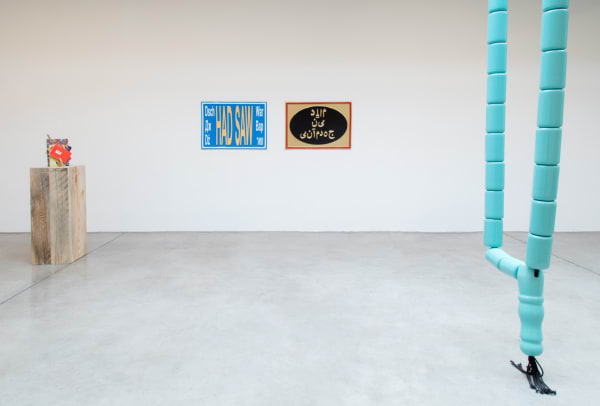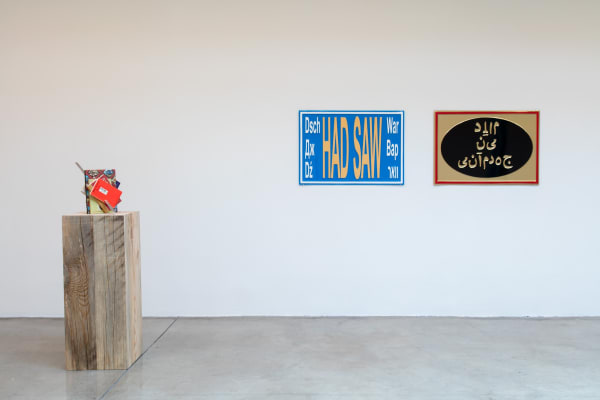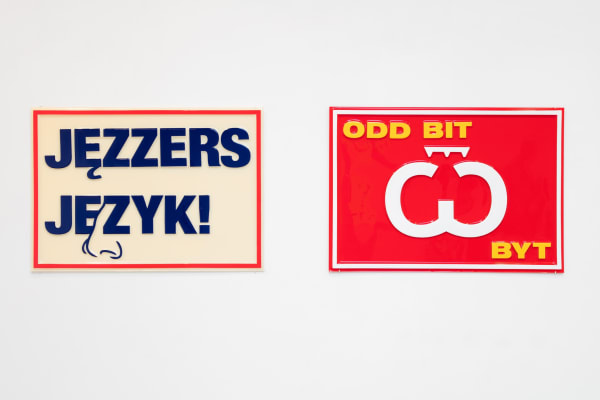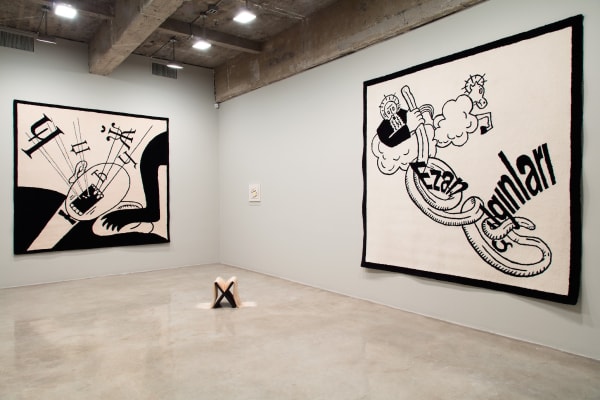Tanya Bonakdar Gallery is pleased to present its first exhibition with artist collective Slavs and Tatars. Featuring a new body of work, Afteur Pasteur challenges our understanding of the self through the unlikely relationship with bacteria and the microbe, the original Other or foreigner. Spanning both floors of the gallery, a fermented milk bar, sculptures, and two-dimensional works continue the collective’s playful exploration of the literary and political geography defined by themselves as “the region east of the former Berlin Wall and west of the Great Wall of China". Their first return to New York since their 2012 MoMA project Beyonsense, Afteur Pasteur collides hidden histories with our present anthropocene moment, collapsing academia and pop culture in one sweep, tongue firmly in cheek. Their newest cycle of research "Pickle Politics” turns to fermentation and souring in order to mine questions about the limits of human knowledge.
In the main gallery, a bacteria bar serves the savory yoghurt drink known in Turkey as ayran: like kumis or kefir, a historically important provision of protein to the nomadic tribes of Central Asia. These drinks' current revival as a foodie and health fad belies a complex historical provenance: after all, it is these same Turkic and Mongol hordes against which Western Civilization has defined itself for more than a millennium. While consuming a cold frothy cup, gallery visitors are able to reflect on our normally antagonistic relationship with bacteria: Afteur Pasteur offers a sour take on the sacred Abrahamic tenet of hospitality.
Throughout the last decade, the collective's work has mined the complexities and unexpected affinities across seemingly disparate cultures through three main activities: publications, lecture-performances, and exhibitions. Much like their stories tease out other stories, these three axes spill into one another, a veritably probioitic approach where books spawn sculptures and lecture-performances are cultured from installations.
Interspersed amongst the bar setting are refitted army cots: each unravels another thread in the unlikely role of fermentation, from militarization to linguistics and cosmology. The works are imbued with a humor that belies their somewhat more serious content matter: playing on the Hebrew etymology of Kumis, Leavened nods to the Jewish origins of the nomadic Turkic tradition of fermented mare's milk found across the steppe. Microcosmos features a re-working of Robert Fludd's Utriusque Cosmi Historia where bacteria replaces man at the center of the universe, an attempt to renegotiate our relationship with the microbe and the microcosmos. Figa challenges the Enlightenment’s emphasis on the rational and the cerebral via a hand gesture considered obscene in some countries and a benediction in others. The thumb protruding from a clenched fist revisits the old Egyptian proverb: “Life is a like a cucumber: one day in your hand and one day in your ass.”
The Kitab Kebab series offers books as a talismanic digestive, a mashup of narratives and texts to be appreciated as much through the gut as the mind. These works illustrate the collective’s appreciation for the high and the low, and the need for transversal, as opposed to horizontal or vertical, knowledge. Each of the vacuum-formed plastic placards from the Tranny Tease series explores a unique instance of transliteration or alphabet politics. The bastardized polyglot cousins of Marcel Broodthaers' "Poèmes industriels", the Tranny Tease address issues as diverse as power and identity and Polish nasal phonemes via the alphabets that accompany empires. These works see the artists asking viewers to conflate ideas or concepts normally thought of as antithetical. Through an amalgam of Russian and German, Kwas ist das skewers recent attempts to market the traditional fermented wheat beverage to Western customers.
In the project space, the Love Letter carpets are inspired by the drawings of Vladimir Mayakovsky, the Futurist poet, playwright and artist who put his verse and skills at the service of the Bolsheviks, bringing him fame but also an early suicide. The carpets are an ode to the 1928 language reform of Turkish from Arabic to Latin script (and subsequent Cyrillization a mere ten years later). The caricatures depict the wrenching experience of having a foreign alphabet imposed on one's native tongue and the linguistic acrobatics required to negotiate such change.
Slavs and Tatars was founded in 2006 and has exhibited in major institutions globally. Their work has been the subject of solo exhibitions at venues including MoMA, NY (2012), Secession, Vienna (2012), Kunsthalle Zurich (2014), Dallas Museum of Art (2014), REDCAT, Los Angeles (2013), GfZK, Leipzig (2014). Group show presentations include the Tate Modern, Centre Pompidou, Museum of Modern Art, Warsaw, 2nd New Museum Triennial, 10th Sharjah, 8th Berlin, 3rd Thessaloniki, and 9th Gwangju Biennials. Currently their work is included in the Köln Skulpturpark and Sonsbeek ’16. A presentation of the artists' lecture-performances is presently being hosted by Fondation Boghossian - Villa Empain, Brussels through October. Later in the year, they will present their lecture-performance 79.89.09 at Stanford University. An upcoming survey marking their ten-year anniversary will tour from CCA Ujazdowski, Warsaw to CAC Vilnius, the Museum of Contemporary Art, Belgrade, and Salt Galata, Istanbul through 2017. Recently the artists' Mirrors for Princes exhibition toured from Kunsthalle Zurich to NYU Abu Dhabi, followed by IMA, Brisbane and most recently the Blaffer Art Museum, Houston. In 2015, they were nominated for Germany’s prestigious Nationalgalerie Preis where their installation won the audience choice award.
All installation images above: Photo by Jean Vong


